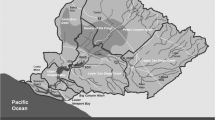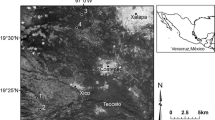Abstract
During 1987–89, organochlorine contaminant levels were measured in American kestrel (Falco sparverius) eggs and in other components of the terrestrial ecosystem in Ontario, Canada. The extent to which these samples were contaminated with DDE varied geographically. Wet weight levels of DDE were greater in eggs from American kestrels (10.8 mg/kg), American robins (Turdus migratorius) (17.3 mg/kg), European starlings (Sturnus vulgaris) (8.8 mg/kg), and eastern bluebirds (Sailia sailis) (7.6 mg/kg) and in samples of earthworms (Lumbricus sp.) (0.6 mg/kg), soil (0.3 mg/kg) and vegetation (8.7 μg/kg) originating from the northern portion of the Niagara Peninsula than elsewhere in southern Ontario. This area is an intensive fruit growing region which received heavy applications of DDT in the past. DDT and its metabolites persist in the soil of this area and are transferred to the biotic community via trophic interactions. DDE may continue to pose a regional hazard to wildlife as a result of these toxic “hot-spots.” In 1987 and 1988, kestrel reproductive success was lower on the northern Niagara Peninsula than at a site in southwestern Ontario. However, it was not possible to attribute this reduced reproductive success to environmental contaminants.
Similar content being viewed by others
References
Agriculture Canada (1974) Memorandum regarding proposed revision in acceptable use claims for DDT. Plant Products Division, Ottawa, Ontario, Canada, May 24, 1974
Anderson DW, Hickey JJ (1972) Eggshell changes in certain North American birds. Proc Int Ornithol Cong 15:514–540
Baril A, Elliott JE, Somers JD, Erickson G (1990) Residue levels of environmental contaminants in prey species of the peregrine falcon, Falco peregrinus, in Canada. Can Field-Naturalist 104:273–284
Beaver DL (1980) Recovery of an American robin population after earlier DDT use. J Field Ornithol 5:220–228
Blumton AK, Fraser JD, Young RW, Goodbred S, Porter SL, Luukkonen DL (1990) Pesticide and PCB residues for loggerhead shrikes in the Shenandoah Valley, Virginia, 1985–1988. Bull Environ Contam Toxicol 45:697–702
Blus LJ, Henny CJ, Stafford CJ, Grove RA (1987) Persistence of DDT and metabolites in wildlife from Washington state orchards. Arch Environ Contam Toxicol 16:467–476
Brown JR JF, Wagner RE, Feng H, Bedard DL, Brennan MJ, Carnahan JC, May RJ (1987) Environmental dechlorination of PCBs. Arch Environ Contam Toxicol 6:579–594
Brown MA, Ruzo LO, Casida JE (1986) Photochemical conversion of a dicofol impurity, α-chloro-DDT, to DDE. Bull Environ Contam Toxicol 37:791–796
Canadian Wildlife Service (1977) Nestboxes for birds. Environment Canada, Ottawa, Ontario, Canada, 7 pp
(1982) Analysis of organochlorine hydrocarbons in tissue samples. In: Environment Canada Analytical Manual. Ottawa, Ontario, Canada
Clark DR, Krynitsky AJ (1983) DDT: Recent contamination in New Mexico and Arizona? Environment 25:27–31
Clarke JU, McFarland VA (1991) Assessing bioaccumulation in aquatic organisms exposed to contaminated sediments. Miscellaneous Paper D-91–2, US Army Engineer Waterways Experiment Station, Vicksburg, MS, 77 pp
Connell DW, Markwell RD (1990) Bioaccumulation in the soil to earthworm system. Chemosphere 20:91–100
Cooke BK, Stringer A (1982) Distribution and breakdown of DDT in orchard soil. Pestic Sci 13:545–551
Craig TH, Trost CH (1979) The biology and nesting density of breeding American kestrels and and long-eared owls on the Big Lost River, southeastern Idaho. Wilson Bull 91:50–61
DeWeese LR, McEwen LC, Hensler GL, Petersen BE (1986) Organochlorine contaminants in passeriformes and other avian prey of the peregrine falcon in the western United States. Environ Toxicol Chem 5:675–693
Dimond JB, Belyea GY, Kadunce RE, Getchell AS, Blease JA (1970) DDT residues in robins and earthworms associated with contaminated forest soils. Can Entomol 102:1122–1130
Elliott JE, Martin PA, Arnold PW, Sinclair PH (1994) Organochlorines and reproductive success of birds in orchard and non-orchard areas of British Columbia, 1990–1991. Arch Environ Contam Toxicol, in press.
Evans MS, Noguchi GE, Rice CP (1991) The biomagnification of polychlorinated biphenyls, toxaphene, and DDT compounds in a Lake Michigan offshore food web. Arch Environ Contam Toxicol 20:87–93
Forsyth DJ, Peterle TJ, Bandy LW (1983) Persistence and transfer of 36Cl-DDT in the soil and biota of an old-field ecosystem: A six-year balance study. Ecology 64:1620–1636
Frank R, Van Hove Holdrinet M, Rapley WA (1975) Residues of organochlorine compounds and mercury in birds' eggs from the Niagara Peninsula, Ontario. Arch Environ Contam Toxicol 3:205–218
Government of Canada (1991) Toxic chemicals in the Great Lakes and associated effects. Vols 1–2. Ministry of Supply and Services Canada, Ottawa, Ontario, Canada
Hamerstrom F, Hamerstrom FN, Hart J (1973) Nestboxes: An effective management tool for kestrels. J Wildl Manage 37:400–403
Harris CR, Sans WW, Miles JRW (1966) Exploratory studies on the occurrence of organochlorine insecticide residues in agricultural soils in southwestern Ontario. J Agric Food Chem 14:398–403
Harris CR, Sans WW (1971) Insecticide residues in soils on 16 farms in southwestern Ontario—1964, 1966, and 1969. Pest Monit J 5:259–267
Henny CJ, Ward FP, Riddle KE, Prouty RM (1982) Migratory peregrine falcons, Falco peregrinus, accumulate pesticides in Latin America during winter. Can Field-Naturalist 96:333–338
Hill EF (1988) Brain cholinesterase activity of apparently normal wild birds. J Wildl Dis 24:51–61
Hughes KD, Weseloh DV, Braune BM (1993) DDE:PCB ratios in Great Lakes herring gull eggs and their use in interpreting contaminants data (in prep)
Kiigemagi U, Terriere LC (1972) Persistence of DDT in orchard soils. Bull Environ Contam Toxicol 7:348–352
Knupp DM, Owen RB, Dimond JB (1976) Pesticide dynamics in robins nesting in contaminated and uncontaminated forests in northern Maine. Can J Zool 54:1669–1673
Kuhr RJ, Davis AC, Bourke JB (1974) DDT residues in soil, water, and fauna from New York apple orchards. Pest Monit J 7:200–204
Lincer, JL (1975) DDE-induced eggshell thinning in the American kestrel: A comparison of the field situation and laboratory results. J Appl Ecol 12:781–793
Macdonald CR, Metcalfe CD (1989) A comparison of PCB congener distributions in two point-source contaminated lakes and one uncontaminated lake in Ontario. J Water Pollut Control Fed Can 24:23–46
Macdonald CR, Metcalfe CD (1991) Concentration and distribution of PCB congeners in isolated Ontario lakes contaminated by atmospheric deposition. Can J Fish Aquat Sci 48:371–381
McEwen F.L. (1970) Pesticides in perspective. In: Air blast equipment and pesticide use in Ontario. Ontario Dept of Health, Pesticides Control Service, pp 63–93
McNicholl MK, Read WF, Weseloh DV (1991) Bluebird nest-box trails in Ontario and their usefulness for bioeffects monitoring of agricultural chemicals. Unpublished report. Canadian Wildlife Service, Burlington, Ontario, Canada, 73 pp
Moxley J (1989) Survey of pesticide use in Ontario, 1988. Ont Ministry of Agriculture and Food Report No. 89-08, 40 pp
Mullins DE, Johnsen RE, Starr RI (1971) Persistence of organochlorine insecticide residues in agricultural soils of Colorado. Pest Monit J 5:268–275
Nagy AC (1963) Population density of sparrow hawks in eastern Pennsylvania. Wilson Bull 75:93
Ontario Ministry of the Environment (1978) The history of DDT in Ontario, Canada. Facts about pesticides, no. 10-01-02
Palmer RS (1962) Handbook of North American birds. Yale University Press, New Haven, CT
Risebrough RW, Jarman WM, Springer AM, Walker W II, Hunt WG (1986) A metabolic derivation of DDE from Kelthane. Environ Toxicol Chem 5:13–19
Rudd RL, Craig RB, Williams WS (1981) Trophic accumulation of DDT in a terrestrial food web. Environ Pollut Ser A 25:219–228
Schwarzbach SE, Fry DM, Rosson BE, Bird DM (1991) Metabolism and storage of p,p′ dicofol in American kestrels (Falco sparverius) with comparisons to ring-neck doves (Steptopelia risoria). Arch Environ Contam Toxicol 20:206–210
Schwarzbach SE (1991) The role of dicofol metabolites in the eggshell thinning response of ring-neck doves. Arch Environ Contam Toxicol 20:200–205
Statistics Canada (1987) Ontario Agriculture, Census Canada 1986. Ministry of Supply and Services, Ottawa, Canada, 281 pp
Stewart KE (1949) Application of DDT sprays by aircraft in Canada for the control of the spruce budworm, Archips fumiferana Clem. In: Forest spraying and some effects of DDT. Department of Lands and Forests, Ontario, Canada. Biol Bull No. 2, pp 93–140
Struger J (1987) Dicofol usage in the Niagara Peninsula area: A preliminary assessment of use patterns. Unpublished report. Canadian Wildlife Service, Burlington, Ontario, Canada, 4 pp
Wiemeyer SN, Porter RD, Hensler GL, Maestrelli JR (1986) DDE, DDT + dieldrin: Residues in American kestrels and relations to reproduction. U.S. Fish and Wildlife Service Technical Report 6, Washington, DC, 33 pp
Author information
Authors and Affiliations
Rights and permissions
About this article
Cite this article
Hebert, C.E., Weseloh, D.V., Kot, L. et al. Organochlorine contaminants in a terrestrial foodweb on the Niagara Peninsula, Ontario, Canada 1987–89. Arch. Environ. Contam. Toxicol. 26, 356–366 (1994). https://doi.org/10.1007/BF00203563
Received:
Revised:
Issue Date:
DOI: https://doi.org/10.1007/BF00203563




